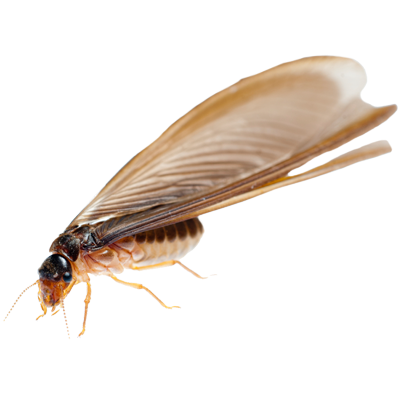When you think of spring, what comes to mind? The return of warm weather? Blooming flowers and budding trees?
Chances are good termites didn’t make your list. But at KC Pest Control, they’re near the top of ours! Spring is the beginning of peak pest season, and termites are some of the worst pests around.
Along with other critters, hungry termites start looking for food when temperatures rise. Termites are pretty well-organized. Before moving their million-bug colony to a new location, they send search teams of swarmers to determine what’s available in the neighborhood.
Swarmers are young queen and king termites with wings. They show up inside buildings early in the spring, and are typically the first sign of a termite problem. Because they’re airborne, people sometimes mistake them for flying ants. Consequently, a lot of folks don’t recognize the threat they pose, and leave a developing termite infestation untreated.
Termites can be found in about 70 percent of the world. There are many kinds of termites, but subterranean termites are most common in Oklahoma. This species lives in underground colonies or in moist secluded areas above ground. Colonies can house up to two million members!
Subterranean termites swarm during the day. They build distinctive “mud tubes” to reach food sources (like your walls!) and to protect themselves from open air. Subterranean termites are by far the most destructive species, as they eat 24 hours a day, seven days a week.

The Circle of (Termite) Life…
It’s important to understand the life cycle of termites, and the signs that a colony has moved into your home or business…
A colony is made up of swarmers, soldiers and workers.
As you’ve learned, swarmers (also called reproductives) have wings. In fact, they have two pair. Sometime after the last freeze – usually when temperatures reach about 70 degrees – young adult male and female swarmers emerge from their nests in large groups.
Swarm flights are short and are aided by prevailing winds. Once they land they break off their wings to symbolize they are a couple. The new couple then selects a nest location, mate, and become king and queen of a new colony. The queen can live over 30 years.
Soldiers and workers do not have wings. They have different support roles. Soldiers are sterile. As their name implies, they exist to protect the colony. Workers maintain the colony, construct and repair the nest, and forage for food for the entire colony.
Initially, colonies grow slowly. The queen will lay between zero and 22 eggs her first year. At the end of that year, the colony may contain as many as 75 individual termites. Many years may elapse before a colony is large enough to cause visible damage.
What to Look For…
How can you tell if termites have invaded? Unless you see the swarmers in flight, it’s hard to know. Here are a few tell-tale signs:
Discarded wings on window sills, around doors, etc. are a good indicator termites have already found their way inside.
Termites require protection, so they build mud tubes from their colony to food sources. Watch for mud tubes around your property, particularly near your foundation.
Look for cracked or bubbling paint, or wood that sounds hollow when tapped. These could be a sign of termites.
What Should I Do?
Termites are destructive. They can cost you lots of money in unexpected home repairs…and they cannot be controlled with do-it-yourself measures.
If you suspect a termite problem, contact KC Pest Control at 405-679-8729 for a free inspection! As qualified termite control specialists, we can quickly determine if termites have taken up residence in your home or business, and stop them from using your place as their hideaway!


